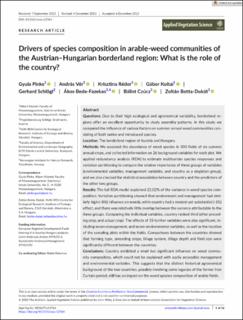Drivers of species composition in arable-weed communities of the Austrian–Hungarian borderland region: What is the role of the country?
| dc.contributor.author | Pinke, Gyula | |
| dc.contributor.author | Vér, András | |
| dc.contributor.author | Réder, Krisztina | |
| dc.contributor.author | Koltai, Gábor | |
| dc.contributor.author | Schlögl, Gerhard | |
| dc.contributor.author | Bede-Fazekas, Ákos | |
| dc.contributor.author | Czúcz, Bálint | |
| dc.contributor.author | Botta-Dukát, Zoltán | |
| dc.coverage.spatial | Østerrike, Ungarn, Austria, Ungarn | en_US |
| dc.date.accessioned | 2024-01-09T12:30:38Z | |
| dc.date.available | 2024-01-09T12:30:38Z | |
| dc.date.created | 2024-01-05T13:08:22Z | |
| dc.date.issued | 2024 | |
| dc.identifier.issn | 1402-2001 | |
| dc.identifier.uri | https://hdl.handle.net/11250/3110618 | |
| dc.description.abstract | Questions: Due to their high ecological and agronomical variability, borderland re -gions offer an excellent opportunity to study assembly patterns. In this study we compared the influence of various factors on summer annual weed communities con -sisting of both native and introduced species. Location: The borderland region of Austria and Hungary. Methods: We assessed the abundance of weed species in 300 fields of six summer annual crops, and collected information on 26 background variables for each plot. We applied redundancy analysis (RDA) to estimate multivariate species responses and variation partitioning to compare the relative importance of three groups of variables (environmental variables, management variables, and country as a singleton group), and we also checked for statistical association between country and the predictors of the other two groups. Results: The full RDA model explained 22.02% of the variance in weed species com -position. Variation partitioning showed that environment and management had simi-larly high (~8%) influence on weeds, while country had a modest yet substantial (~1%) effect, and there was relatively little overlap between the variance attributable to the three groups. Comparing the individual variables, country ranked third (after preced-ing crop, and actual crop). The effects of 15 further variables were also significant, in -cluding seven management, and seven environmental variables, as well as the location of the sampling plots within the fields. Comparisons between the countries showed that farming type, preceding crops, tillage system, tillage depth and field size were significantly different between the countries. Conclusions: Country exhibited a small but significant influence on weed commu-nity composition, which could not be explained with easily accessible management and environmental variables. This suggests that the distinct historical agronomical background of the two countries, possibly involving some legacies of the former Iron Curtain period, still has an impact on the weed species composition of arable fields. agriculture, annual crops, arable weeds, climate, country effect, ecological legacy, Iron Curtain, variance partitioning, weed survey, weed vegetation | en_US |
| dc.language.iso | eng | en_US |
| dc.rights | Navngivelse-Ikkekommersiell 4.0 Internasjonal | * |
| dc.rights.uri | http://creativecommons.org/licenses/by-nc/4.0/deed.no | * |
| dc.subject | agriculture | en_US |
| dc.subject | annual crops | en_US |
| dc.subject | arable weeds | en_US |
| dc.subject | climate | en_US |
| dc.subject | country effect | en_US |
| dc.subject | ecological legacy | en_US |
| dc.subject | Iron Curtain | en_US |
| dc.subject | variance partitioning | en_US |
| dc.subject | weed survey | en_US |
| dc.subject | weed vegetation | en_US |
| dc.title | Drivers of species composition in arable-weed communities of the Austrian–Hungarian borderland region: What is the role of the country? | en_US |
| dc.title.alternative | Drivers of species composition in arable-weed communities of the Austrian–Hungarian borderland region: What is the role of the country? | en_US |
| dc.type | Peer reviewed | en_US |
| dc.type | Journal article | en_US |
| dc.description.version | publishedVersion | en_US |
| dc.rights.holder | © 2044 The Authors | en_US |
| dc.subject.nsi | VDP::Zoologiske og botaniske fag: 480 | en_US |
| dc.subject.nsi | VDP::Zoology and botany: 480 | en_US |
| dc.source.volume | 27 | en_US |
| dc.source.journal | Applied Vegetation Science | en_US |
| dc.identifier.doi | 10.1111/avsc.12764 | |
| dc.identifier.cristin | 2221423 | |
| dc.relation.project | European Regional Development Fund: Interreg V-A Austria-Hungary projects ATHU51 & ATHU135 | en_US |
| dc.source.articlenumber | e12764 | en_US |
| cristin.ispublished | true | |
| cristin.fulltext | original | |
| cristin.qualitycode | 1 |
Tilhørende fil(er)
Denne innførselen finnes i følgende samling(er)
-
Publikasjoner fra CRIStin - NINA [2364]
-
Scientific publications [1392]
Vitenskapelige artikler, kapitler og monografier i Open Access.

